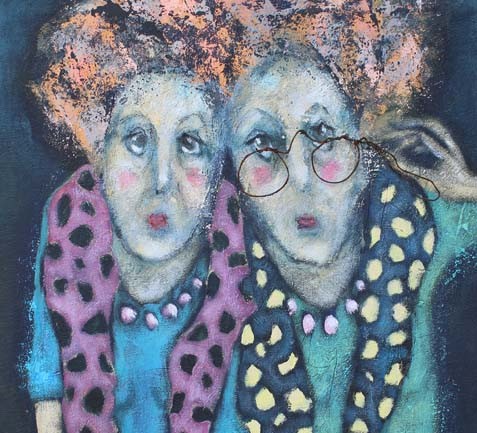Drawing values – what on earth are values?

I had completely underestimated the importance of values in my painting or drawing. I can have a great composition, wonderful colors, but if the values are not well balanced, the painting doesn’t work. Let’s analyze our paintings and exercise drawing values!
What are values?
Values in art are the LIGHTNESS and DARKNESS on a black to white scale of your painting or drawing. Simply imagine that you take a picture of something, modify it to black and white. What you will see, are different values. (the light turquoise might be lighter than a dark yellow…)
Using values before shading
Do not confuse values with shading. Imagine a lemon next to an aubergine. First, we would have to indicate the value of each item (the aubergine is darker than the lemon) and then the shadows. So much said in sketching, it can look great to draw outlines and add some shading., without working with values. In painting on the other hand that works less.
Value range
In general, we use a bit fewer values in drawings (often 3-5) while in painting we can reach easily 8-10. A painting that hits them all from white to (almost) black comes across as really powerful.
Especially in the beginning, we tend to linger around 2-3 values, often in the grey field. It takes some courage to use darks and lights.
I have even heard the expression…she is a grey painter. They were not talking about a grey painting but about someone not using many different values.

Check the values of your own painting
While painting, I check my values long before I am done.
Here an example. I was working on a flower series. Even though the painting was not done I was curious to see how my values are doing.. it felt still messy….

I took a picture with my phone and changed it to black and white

Looking at this, I realized most of the darks were on the left side and the whole painting had a lot of middle grey tones. I took a finished flower painting that I was happy with and took a black and white picture.

The image is a bit lighter than in reality but we can still analyze it.
Some darks are a bit strong but at least there is a balance where they are placed. Lights are found throughout the painting, there are middle tones and we also have contrast. Below how the painting looks in color.
It is your turn to check your paintings!!! If they look like my painting in progress, no worries modify your values by adding lighter and darker colors!
Drawing values
Now let’s finally get to the drawing part! It is incredibly useful to practice sketching values. You become so much more aware of it, rather than concentrate on colors immediately.
I often make small thumbnails before I work bigger. It helps me to observe the values but also the composition.
What materials work best for drawing values?
For small formats, fine line pens and simple pencils work really well. You can also use watercolor but make sure you paint monochrome to see the values.

So, let’s make a simple value study in form of a thumbnail. Get some paper and a pen or pencil and join me for a little sketch!
Practicing suggestion
1. Draw or paint a value scale with 5-10 different values!
2. .Draw a few thumbnails of anything inside your house or outdoors. It is a lot of fun to make mini landscapes
2. Take a picture of one of your paintings that you are not particularly happy, modify the image to black and white, check the values, and share it with us!!
I would love to hear how your value checks went. Please post them on my closed FB group or below in the comments! Click here
If you have missed some previous drawing foundation posts: click for the list here: There are links to each post:
Posts you might enjoy:
How to start a drawing
2 Drawing tips for beginners that are easy but powerful!











